Deadly divers
Diving deep for walleyes
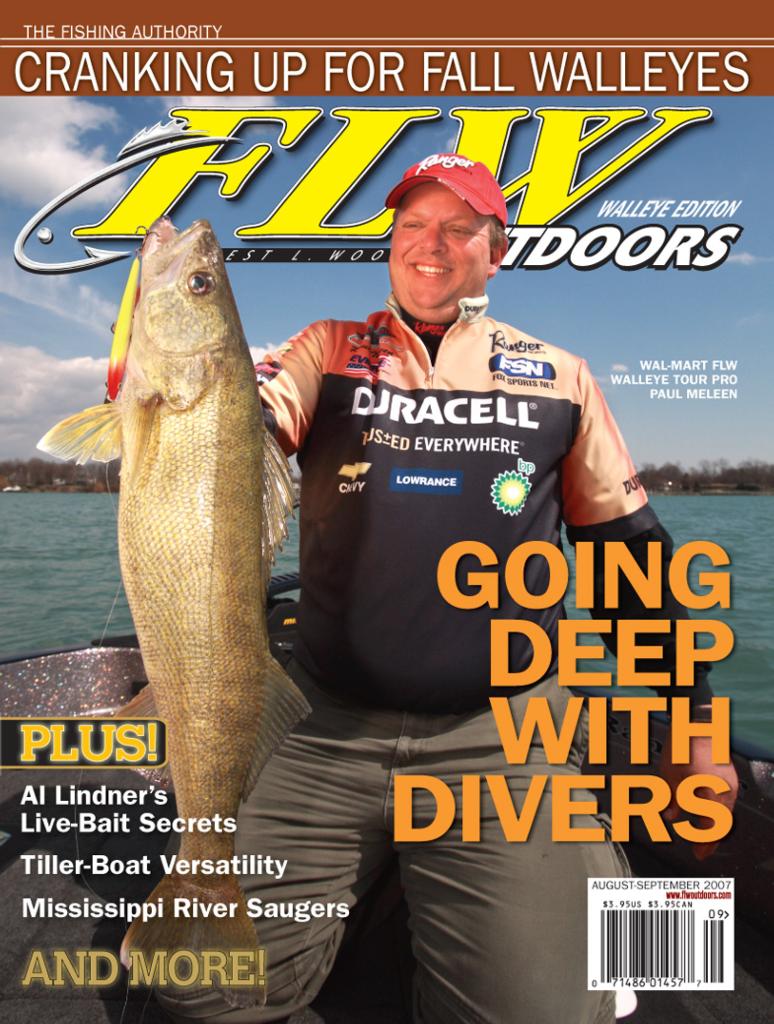
We walleye anglers tend to think it’s all about us, and the fishing universe revolves around our favorite species. Well, time for a reality check. Most open-water-trolling techniques – planer boards, divers, downriggers, etc. – evolved out of big-water trout and salmon markets, where trolling multiple lines is not only common, but almost mandatory. Some trolling devices were actually designed for fishing rivers – a wrinkle few walleye fishermen have adopted.
Some may wonder why anyone would bother using a diver. The answer is simple: to run your lures deeper than they are able to dive on their own. The advanced answer is that some divers also run your baits out to the side, float at rest, trip their triggers on demand to rise toward the surface, and perform a few other fancy and unexpected maneuvers. In essence, they don’t just dive; they thrive in the wide-open spaces of offshore walleye-trolling adventures.
Of the various diver styles on the market, two versions of primary importance are directional divers like the Luhr Jensen Dipsy Diver and floater divers like the Luhr Jensen Jet Diver. Let’s examine their respective advantages.
Dipsy Divers tie onto your main line and connect to your lure via a leader of one rod length or less. They angle facedown to dive, pulling your lure or bait down into the depths. The more line you let out, the deeper they go, until eventually reaching their maximum diving potential. They come in several different sizes, allowing you to easily probe depths to 70 feet, sometimes deeper.
Dipsys also have an adjustable weighted keel that allows them to plane left or right, simultaneously angling your lines out to the sides of the boat, as well as downward. The size of the diver, length of line and angle of the dangle, in combination, result in a directional diver that reaches down and out for walleyes. A correctly positioned squadron of Dipsys surrounds your boat with an array of lures saturating different depth levels – all without tangling.
When a fish strikes, a release mechanism pops, causing the planer to de-angle and forfeit its diving capacity. This enables you to retrieve a hooked fish to the boat without undue resistance from the diver. It’s pretty ingenious, really. It relentlessly digs deep until the moment of truth, then surrenders and comes in like a lamb.
Like all divers, Dipsys work best with level-running baits like spoons or spinner harnesses, or shallow-diving lures like minnow-imitator crankbaits. Don’t try them with deep-diving cranks, however; the diving characteristics of each will compete with the other, diminishing ultimate diving depth.
Walleye anglers typically use four to six Dipsy Diver rods to position lines for deep trolling passes. First, the shallowest and widest planers are sent out far to the sides of the boat, and the rods are set in the farthest-forward rod holders along each gunwale. The next two Dipsy lines are set to dive down and slightly out to the sides and set in the next rod-holder positions toward the transom. The last two divers are set to dive virtually straight down, with the rods stored in the rod holders nearest the transom.
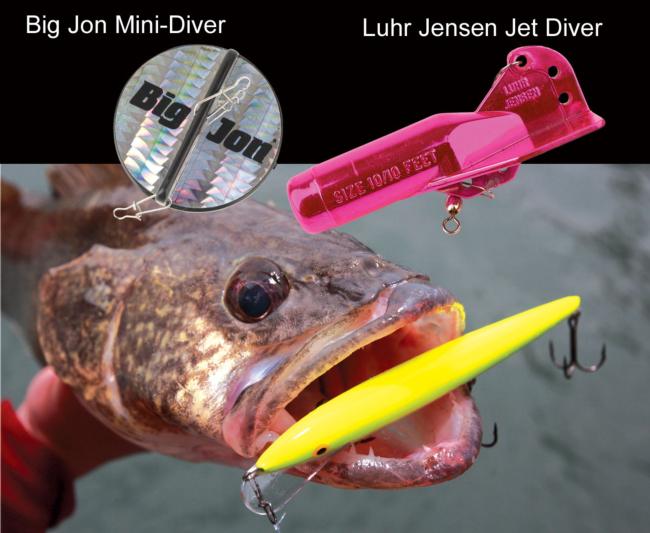 As you troll along, it’s easy to change running depth without having to reel in, add sinkers or change setups. Basically, just lengthen or shorten your lines to increase or decrease running depths. Dipsys pull so hard they take the stretch out of your lines and respond well to line-length adjustments. They also require long, beefy rods, large-capacity line-counter reels for storage and lines of at least 17- to 20-pound test to withstand the relentless punishment of trolling. Just be sure to set your drag to slip a bit on impact, because something’s gotta give.
As you troll along, it’s easy to change running depth without having to reel in, add sinkers or change setups. Basically, just lengthen or shorten your lines to increase or decrease running depths. Dipsys pull so hard they take the stretch out of your lines and respond well to line-length adjustments. They also require long, beefy rods, large-capacity line-counter reels for storage and lines of at least 17- to 20-pound test to withstand the relentless punishment of trolling. Just be sure to set your drag to slip a bit on impact, because something’s gotta give.
When a sizeable fish strikes, the Dipsy release generally trips, and you’re able to fight the fish unhindered. It swings back behind the boat, and you net it over the transom. Once the fish is unhooked, you can simply reset the trip mechanism, drop the lure and Dipsy back into the water, and send it back out again. The remarkable thing is the preset diving angles cause Dipsys to return to their prior positions in your trolling spread without all the line-shuffling gyrations necessary with planer boards and weighted lines. Dipsys sort of swoop back into their proper places as you feed the line out under tension.
If a small fish strikes, you may not notice because the release may not trigger (no-stretch Berkley FireLine typically trips releases more dependably than more stretchy mono). Watch your rod tips, however, and you should be able to see a change in the vibrating tip action that betrays the vibration of your lure. If you have any doubts, just lift the rod out of the holder, point it straight back at the lure, and give it a sudden upward sweep to pop the release. The drawback with most divers is you must reel them all the way back in to reset the release, then send them back out again. Kastaway Magnetic 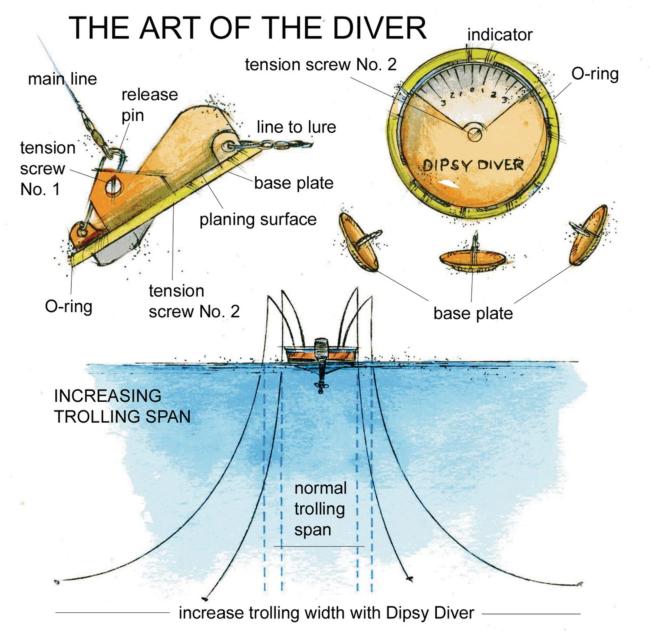
Divers, however, are resettable at a distance. Just give them a brief period of slack, and the magnetic release mechanism should re-engage.
Once you become familiar with how Dipsys run in combination with different lure styles, line lengths and trolling speeds, you can run lures barely inches above a uniform basin, swing them up along the edge of a drop-off, or fish them in tandem with planer boards or lead-core lines. They’re actually pretty simple to use, as long as you’re willing to accommodate their brutish diving power with heavy tackle. That concession is the biggest barrier to most walleye anglers, however; they simply can’t accept fishing for walleyes with salmon-type tackle.
Pop the clutch and raise a touch
Assume you’re trolling along and your electronics reveal a school of fish suspended higher in the water column than your lures are running. You could furiously wind in and shorten a line or two to reduce lure depth. Or, simply grab a rod or two out of their holders, point the tips straight back at the lures, and give them a sharp upward sweep to trip the release mechanism. Then place the rods back in the holders.
With the planers de-angled, the lines begin rising under trolling tension, lifting your lures up through the school. Hopefully, your first trolling pass through the located school raises at least one or two lures through the fish’s level and triggers strikes. As you pass the school and begin circling back for another pass, reel in the tripped lines. Then, as you come out of the turn, reset their release mechanisms, and send the Dipsys back out on the proper lengths of line to place the lures at ‘eye level.
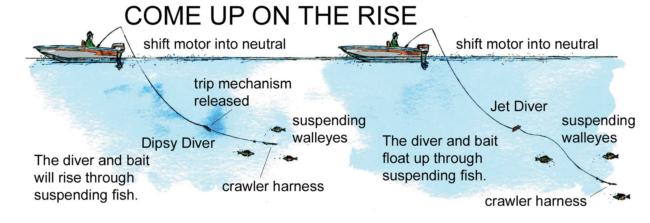
Float some and jet some
Jet Divers are unique among diving devices in that they plane downward under tension, but float at rest. In essence, they react just the opposite of a sinker when you slow down or shift the motor into neutral. This maneuver not only raises lures to fish that are above the Jet’s running level, but shows walleyes a different triggering mechanism than weighted lines, which drop as speed slows. And the nice thing is once Jets rise too high to be effective, just re-engage your motor to begin trolling again, and your Jets will dig back down again.
Like Dipsys, Jets dive only so deep. Fortunately, there are five sizes to cover different depth levels, handily designated as models 10, 20, 30, 40 and 50 to ply down as many feet. It removes much of the brain strain from diver selection; just pick the right-sized Jet for the approximate depth, fine-tune line length a little, and you’re all set.
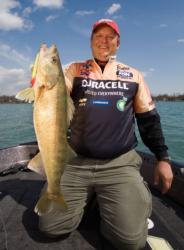 Unlike Dipsys, Jets only dive straight down, not out to the sides. They also place considerably less strain on your tackle, allowing you to use “more normal” gear and as little as 10-pound-test line. Jets seem particularly effective with slower-speed presentations like large-bladed crawler harnesses, especially when fished in the top 20 feet nearest the surface. If you need to send them out to the sides to minimize spooking, feed out line to drop them back, and then pop a planer board onto the line to disperse them to either side of the boat. This is not a bad trick with the smaller sizes of Dipsys, either, perhaps angling them slightly out and away from the planer board as well.
Unlike Dipsys, Jets only dive straight down, not out to the sides. They also place considerably less strain on your tackle, allowing you to use “more normal” gear and as little as 10-pound-test line. Jets seem particularly effective with slower-speed presentations like large-bladed crawler harnesses, especially when fished in the top 20 feet nearest the surface. If you need to send them out to the sides to minimize spooking, feed out line to drop them back, and then pop a planer board onto the line to disperse them to either side of the boat. This is not a bad trick with the smaller sizes of Dipsys, either, perhaps angling them slightly out and away from the planer board as well.
River wrangles
Jet Divers were originally designed for fishing in river current, not for open-water trolling. They make mighty good big-water divers, however, and it would be a shame not to evaluate their origin for potential walleye use. They work particularly well in river sections that exceed 10 to15 feet in depth, using the proper-sized Jet to reach near bottom.
Trout and salmon anglers use Jets to take baits deeper in current. It’s easy to see how one could tie in a Jet 5 or 6 feet ahead of a wiggling Rapala Shad Rap crankbait, wobbling Kwikfish banana-shaped bait, or even a spinner-crawler harness, and troll slowly upstream, into the current. The combined pressure of the current and trolling speed makes baits really wobble.
Even hovering in place, dangling a lure just above fish, could be deadly. You could even do it with a minnow or night crawler simply hooked on a leader, anchored in place, adjusting line length occasionally to fish different portions of a hole. When a rod bends, don’t be in a hurry to set the hook; let the fish hook itself. And if the Jet snags up, give it a little slack line, and the current should push and lift the buoyant Jet off bottom and float it downstream.
Salmon anglers often set their throttle to not quite offset the force of the current, allowing their boats to slip slowly downstream, lines dangling downcurrent behind the boat. As they do, they watch for fish activity on the surface. Big fish like steelhead and salmon routinely show themselves when swimming upstream, with their fins and tails breaking the surface. When anglers see this, they angle their boat left or right, moving their lines and lures directly above the spotted fish. Then they continue to slip downstream, sending their lures directly through the spot where fish were sighted. It’s like reaching downstream and plucking them before they know you’re there, tickling their fancy with a stealthy approach.
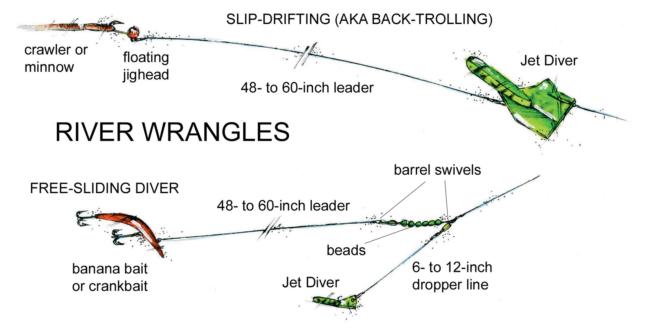
Not many walleyes fin the surface as they move upstream. But the fact remains, when you fish a river hole, this tactic has a lot of potential. Hover upstream of the hole, send your Jets, lures and lines downstream, and let them wiggle. Angle your boat a bit left and right, sweeping your lure left-right-left across the front of the hole, much like handliners do with their heavy rigs when fishing in the swift Detroit River. Then reduce your throttle just a hair to begin slipping downstream. Hover again where necessary. Shift left-right to sweep and place your lures exactly where you wish. Let out a little more line to send Jets and lures down deeper into the basin of the hole. Systematically cover the entire hole from an upstream position without spooking the fish.
Obviously, this slip-drift method requires sufficient current to make the diver dive and to wobble your baits when hovering and slowly slipping with the current. You can even rig your lures on a free-sliding diver arrangement that functions much like a three-way rig, with the diver at the bottom and the lure trailing above and behind … which sounds suspiciously walleye-ish to me.
Diverse divers
Alas, divers can’t do everything, but they can do a surprising number of things if you’re willing to give them a try. Among walleye anglers, they’ll likely always be considered hardware for big-water trolling and suspended fish. They are far less speed-dependent than planer boards and lead core, and they tend to maintain running depths despite changes in speed, rough water conditions and turns. Spinner speeds of 1 mph to spoon speeds of 3 mph, and all crankbait speeds in between, are fair game. Plus, they come in a rainbow of color patterns to serve as brilliant attractors, forage imitations or subtle, dull shades to blend into the environment, rather than stand out in contrast.
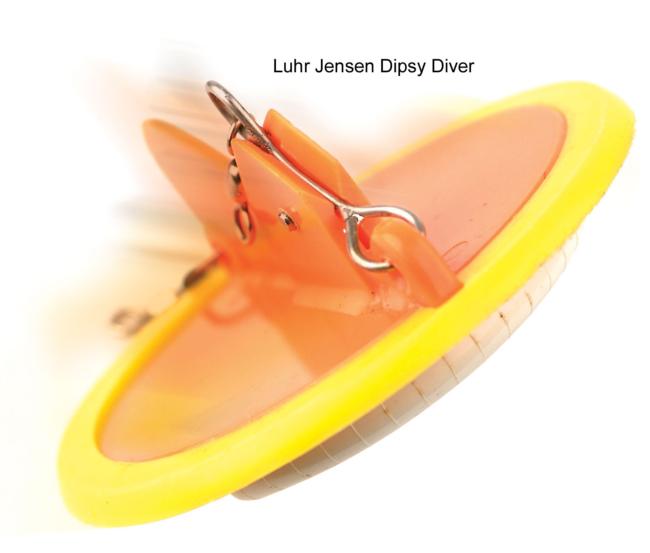 Inland anglers fishing smaller waters should consider the divers’ distinct trolling advantages as well. You can use them to sweep lures up alongside a weedbed; above or alongside suspended timber; up against bluff banks; or, as we suggested, in river current. Their incredible diversity is simply too great to ignore.
Inland anglers fishing smaller waters should consider the divers’ distinct trolling advantages as well. You can use them to sweep lures up alongside a weedbed; above or alongside suspended timber; up against bluff banks; or, as we suggested, in river current. Their incredible diversity is simply too great to ignore.
No matter what you think of the diver parade, when the Wal-Mart FLW Walleye Tour Championship comes to the Lake Erie waters off Cleveland this fall, it’s likely most of the big walleyes caught during the contest will come on diver tactics. When faced with 40- to 55-foot basins, migratory walleyes lying or hovering near bottom, and wide-open spaces to troll, the odds go to the old Dipsy do. If Dipsys don’t, I’ll be surprised.
